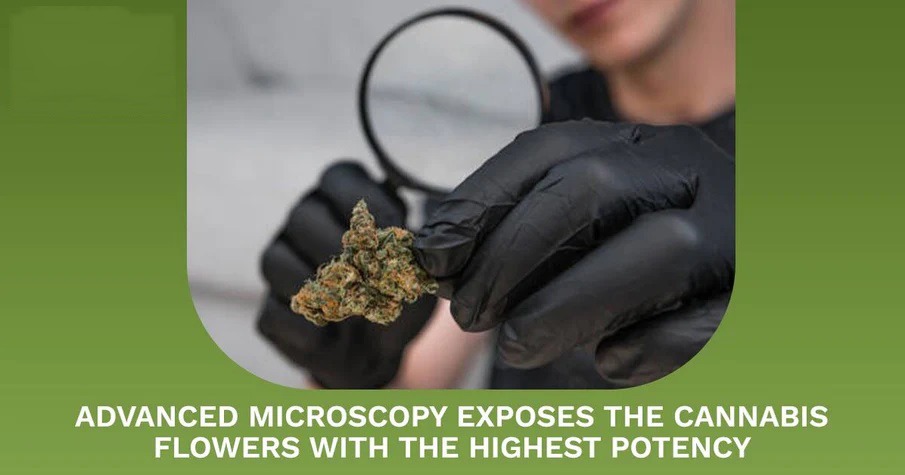State of the Art
Advanced Microscopy Exposes the Cannabis Flowers with the Highest Potency
Cannabis Flowers with the Highest Potency – Advanced microscopy techniques have indeed been used to study and analyze the intricate structures of cannabis flowers, including trichomes, which are the resin-producing glands responsible for the production of cannabinoids, terpenes, and other valuable compounds. While these techniques can provide valuable insights into the morphology and chemical composition of cannabis flowers, they are not capable of directly measuring the potency of the flowers.
The potency of cannabis flowers is primarily determined by the concentration of cannabinoids, such as tetrahydrocannabinol (THC) and cannabidiol (CBD). To accurately measure potency, specialized laboratory techniques are used, such as high-performance liquid chromatography (HPLC) or gas chromatography (GC), which can quantify the levels of cannabinoids present in a given sample.
Microscopy techniques, such as scanning electron microscopy (SEM) or confocal microscopy, can complement potency testing by providing visual information about the trichomes and their development stages. Trichomes are small, hair-like structures on the surface of cannabis flowers and leaves, and their density, size, and shape can give an indication of the plant’s maturity and potential potency.
By using advanced microscopy, researchers can examine trichomes at high magnification, allowing them to observe features like glandular heads and stalks. These structures can vary in appearance depending on the stage of development and the genetic characteristics of the cannabis strain. However, the direct measurement of potency still requires separate laboratory analysis.
It’s important to note that the potency of cannabis flowers can also be influenced by factors beyond trichome appearance, such as environmental conditions, cultivation techniques, and genetic variations within strains. Therefore, while advanced microscopy can provide valuable insights into the structure and development of cannabis flowers, it is not a substitute for laboratory testing when it comes to determining potency accurately. Read more about the research on scitechdaily
What Is The Most Potent Part Of a Cannabis Plant – Cannabis Flowers with the Highest Potency
The most potent part of a cannabis plant in terms of cannabinoid concentration, particularly THC (tetrahydrocannabinol), is typically the flowering buds or flowers themselves. The flowers of female cannabis plants contain the highest concentrations of cannabinoids, including THC and CBD (cannabidiol).
The trichomes, which are the resinous glands found on the surface of the flowers, are responsible for producing and storing these cannabinoids. Trichomes contain the highest concentrations of THC, which is the primary psychoactive compound in cannabis.
When the flowers mature and reach their peak potency, the trichomes become more abundant and develop a milky or amber color. This is an indication that the THC content is at its highest level. At this stage, the flowers are typically harvested for medicinal or recreational use.
It’s worth noting that different parts of the cannabis plant can contain varying levels of cannabinoids, albeit generally lower than the flower buds. For example, the leaves and stems also contain cannabinoids but in lower concentrations compared to the flowers. These other plant parts are sometimes used in the production of cannabis products such as edibles, topicals, or extracts.
Overall, the flowers or buds of the cannabis plant are typically the most sought-after and potent part due to their high concentrations of cannabinoids, making them desirable for various purposes.
What Makes Buds More Potent?
Several factors contribute to making cannabis buds more potent:
- Genetic Strain: The genetic makeup of the cannabis strain plays a significant role in determining its potency. Different strains have varying levels of cannabinoids, including THC and CBD. Some strains are naturally bred to have higher THC concentrations, resulting in more potent buds.
- Trichome Density: Trichomes are the resinous glands that contain cannabinoids, terpenes, and other compounds. Buds with higher trichome density tend to be more potent. Trichomes are often visible as small, crystal-like structures on the surface of the buds. The greater the number of trichomes, the more cannabinoids are present, leading to increased potency.
- Trichome Maturity: Trichomes undergo changes in appearance as they mature. Early in their development, trichomes may be clear or transparent. As they mature, they become milky white and eventually develop an amber color. Buds harvested at the peak of trichome maturity, when the majority of trichomes have turned milky or amber, are generally more potent.
- THC and CBD Ratios: The ratio of THC to CBD can influence the potency and effects of cannabis buds. THC is the primary psychoactive compound, while CBD is known for its potential therapeutic properties. Buds with higher THC concentrations relative to CBD are typically considered more potent in terms of their psychoactive effects.
- Growing Conditions: Environmental factors during cultivation, such as lighting, temperature, humidity, and nutrient levels, can impact the potency of cannabis buds. Optimal growing conditions that provide the right balance of light, nutrients, and water can help maximize the potential potency of the buds.
- Harvesting and Curing: The timing of the harvest and the curing process can affect the potency of cannabis buds. Harvesting too early may result in buds with lower cannabinoid levels, while harvesting too late could lead to degraded cannabinoids. Properly drying and curing the buds after harvest helps preserve their potency.
It’s important to note that potency alone does not determine the overall quality or desired effects of cannabis. The combination of different cannabinoids, terpenes, and other compounds present in the buds contributes to the unique characteristics and effects of each strain. Different individuals may have varying preferences for the balance of cannabinoids and terpenes that suit their needs and preferences.
What Does High Potency Mean?
High potency, in the context of cannabis, refers to the elevated concentration of certain chemical compounds, primarily cannabinoids, found in cannabis products. The term is often used to describe cannabis strains or products that contain higher levels of cannabinoids, particularly THC (tetrahydrocannabinol), which is the primary psychoactive compound responsible for the intoxicating effects of cannabis.
When a cannabis strain or product is referred to as high potency, it means that it contains a greater concentration of cannabinoids, typically THC, compared to other strains or products. This increased potency can result in more pronounced psychoactive effects, such as euphoria, relaxation, increased appetite, and altered sensory perception.
Cannabis strains or products with high potency are sought after by individuals who desire stronger or more potent effects. However, it’s important to note that individual tolerance and sensitivity to cannabinoids can vary, and what may be considered high potency for one person might be different for another.
High potency strains or products are often preferred by recreational cannabis users looking for more intense psychoactive experiences. Additionally, some medical cannabis patients may seek high potency strains for therapeutic purposes, particularly for conditions that may benefit from higher THC concentrations, such as chronic pain, nausea, or muscle spasms.
It’s crucial to approach high potency cannabis products responsibly and be aware of the potential for increased psychoactive effects. It’s recommended to start with lower potency products or strains and gradually adjust the dosage based on individual tolerance and desired effects.

